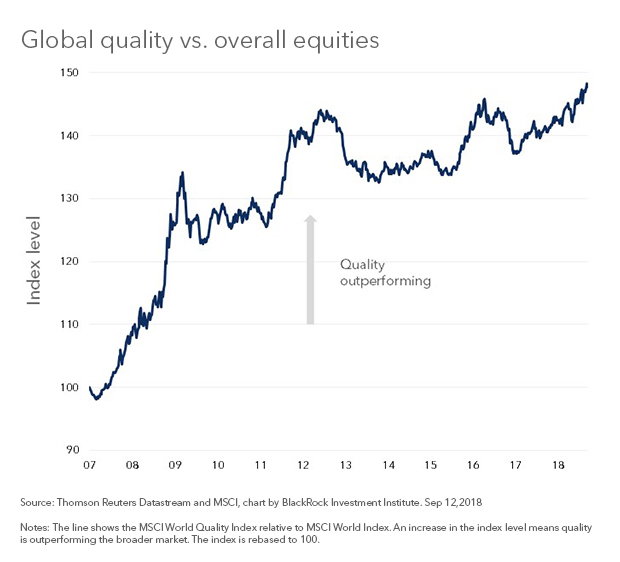by Russ Koesterich, Portfolio Manager, Blackrock
While momentum stocks have prevailed since 2016, is quality about to have its day? Possibly, if volatility continues to rise, as Russ discusses.
Growth stocks’ extended dominance over value has captured the headlines of late. That said, since the end of 2016 it has really been about momentum. While investors have focused on earnings growth, an even better approach would have been to simply buy the stocks rising the fastest, otherwise known as momentum investing.
Year-to-date, momentum continues to outperform the rest of the market, but the regime may be shifting towards a different equity style. As I discussed last February, when uncertainty and volatility are rising, quality tends to outperform. As trade issues have escalated, this has once again proved the case. Since the early summer, companies in the MSCI Quality Index have outperformed other investment styles as well as the broader market (see Chart 1).
To review, quality companies generally include firms with high return-on-equity (ROE), earnings consistency and low leverage. These characteristics suggest safety, which investors put a premium on when volatility is moving higher.
While volatility remains low by historic standards, it is on the rise. Last year volatility was anemic, with the VIX Index averaging just above 11, well below its long-term average of 20. However, during the past six months the VIX has averaged close to 15, a 34% increase. Assuming volatility continues to normalize, historically this has been the type of market when quality has been the most valuable.
Quality is most effective when the VIX spikes
As a refresher, it is generally a good idea to hold some quality in a portfolio. Since 1994 quality, measured by the MSCI U.S. Quality Index, has produced higher monthly average returns than the S&P 500. In addition, the relative performance of quality versus the S&P 500 tends to be highest when the VIX is rising.
In months when the VIX is higher quality beats the S&P 500 by approximately 40 basis points (bps, or 0.40%). This outperformance becomes more pronounced in months when the VIX rises by more than 25%. In those month’s quality beats the market by approximately 0.90% on average.
Volatility likely to keep creeping higher
To the extent volatility has been a catalyst for quality’s relative strength, what should investors expect going forward? My view is that volatility continues to rise into the end of the current cycle. Putting aside the wild card of an escalating trade dispute, it is important to note that volatility typically rises towards the latter stages of bull markets, when financial conditions are tightening. This is a fair description of where we are today.
Wider credit spreads would be a good reason to hold more quality in your portfolio. A credit spread is the difference between the yields of a U.S. Treasury and another bond of the same maturity. When they widen, it is typically of a sign of economic uncertainty, as investors buy “safe harbor” Treasuries and sell riskier bonds.
To date, rising rates and a stronger dollar have contributed to tighter financial conditions. What has offset these trends is still tight credit spreads. Benign credit markets have reassured investors and helped to keep financial conditions easier than you would expect. A widening of spreads, particularly for high yield bonds, would confirm a higher volatility regime. When that happens, volatility is likely to jump rather than creep higher, exactly the type of regime when quality’s relative performance has been strongest.
Russ Koesterich, CFA, is Portfolio Manager for BlackRock’s Global Allocation team and is a regular contributor to The Blog.
















